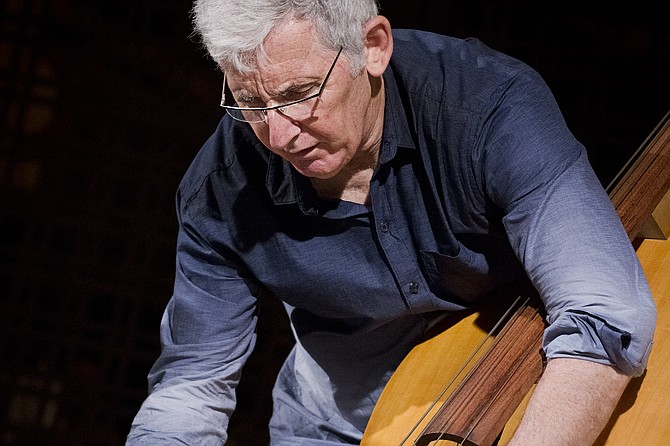 Facebook
Facebook
 X
X
 Instagram
Instagram
 TikTok
TikTok
 Youtube
Youtube

He played San Diego County Mental Health and watched a patient attack another patient during “Freedom Jazz Dance.” He went back to San Diego County Mental Health and made it through a “chilled” set of Stevie Wonder songs. He watched a patient die during a gig at a rest home. He enjoyed playing with Diamanda Galas. But these days, he’s most interested in playing over the computer with a bunch of folks from around the country, and around the world.
He’s Mark Dresser, double-bass virtuoso and long-time professor at UCSD. He’s performed with the San Diego Symphony Orchestra and with too many jazz musicians to name. But his main interest over the last few years — since long before the virus struck — is telematics: the art and science of plugging in to play with other in real time.
He’s tackled big agendas before, including a double-focus on both jazz and classical music. “Both traditions, as well as free improvisation and composition, have always been part of my musical life. In 1972, I was concurrently playing with the free jazz group in LA, Black Music Infinity, led by the well-known writer Stanley Crouch with Bobby Bradford, Arthur Blythe, James Newton, and David Murray, while at the same time I had a contract with the San Diego Symphony.”
“To this day I teach classically via repertoire and its pedagogy, contemporary music repertoire, jazz repertoire, and improvisation. Musicianship cuts through it all, and in combination with knowing your instrument, emerging opportunities arise which nurture rich musical relationships and friendships that continue throughout one’s life.”
To Dresser, making music long-distance seemed a formidable, but not insurmountable challenge. “I got interested in telematic music,” he relates, “after relocating to San Diego to teach at UCSD in 2006. After 18 years in New York City, I found myself artistically separated from my natural community of collaborators. I had a need to connect, not dissimilar to the moment we are living now in the Covid era.
“Network music performance is not plug-and-play,” he stresses. “At the beginning, our goal was to play the same concert as if we were there in person, always compared to the live concert. 13 years later, it is clear that telematics is an audio visual medium with properties and poetics that are uniquely rich and magical.”
“Why do this? Because it exercises the best kind of collaborative muscle, unleashing the creative potential between artists and technologists, of good will to problem solve and work together. The implications of this kind of process transcends the medium itself.”
He’s proud to teach and play, although he allows: “The most challenging part of teaching is being organized enough with my time, so that I can maintain a decent level of my own playing, as well as push new envelopes of composition and teach at my highest level. So I can walk the walk.”


He played San Diego County Mental Health and watched a patient attack another patient during “Freedom Jazz Dance.” He went back to San Diego County Mental Health and made it through a “chilled” set of Stevie Wonder songs. He watched a patient die during a gig at a rest home. He enjoyed playing with Diamanda Galas. But these days, he’s most interested in playing over the computer with a bunch of folks from around the country, and around the world.
He’s Mark Dresser, double-bass virtuoso and long-time professor at UCSD. He’s performed with the San Diego Symphony Orchestra and with too many jazz musicians to name. But his main interest over the last few years — since long before the virus struck — is telematics: the art and science of plugging in to play with other in real time.
He’s tackled big agendas before, including a double-focus on both jazz and classical music. “Both traditions, as well as free improvisation and composition, have always been part of my musical life. In 1972, I was concurrently playing with the free jazz group in LA, Black Music Infinity, led by the well-known writer Stanley Crouch with Bobby Bradford, Arthur Blythe, James Newton, and David Murray, while at the same time I had a contract with the San Diego Symphony.”
“To this day I teach classically via repertoire and its pedagogy, contemporary music repertoire, jazz repertoire, and improvisation. Musicianship cuts through it all, and in combination with knowing your instrument, emerging opportunities arise which nurture rich musical relationships and friendships that continue throughout one’s life.”
To Dresser, making music long-distance seemed a formidable, but not insurmountable challenge. “I got interested in telematic music,” he relates, “after relocating to San Diego to teach at UCSD in 2006. After 18 years in New York City, I found myself artistically separated from my natural community of collaborators. I had a need to connect, not dissimilar to the moment we are living now in the Covid era.
“Network music performance is not plug-and-play,” he stresses. “At the beginning, our goal was to play the same concert as if we were there in person, always compared to the live concert. 13 years later, it is clear that telematics is an audio visual medium with properties and poetics that are uniquely rich and magical.”
“Why do this? Because it exercises the best kind of collaborative muscle, unleashing the creative potential between artists and technologists, of good will to problem solve and work together. The implications of this kind of process transcends the medium itself.”
He’s proud to teach and play, although he allows: “The most challenging part of teaching is being organized enough with my time, so that I can maintain a decent level of my own playing, as well as push new envelopes of composition and teach at my highest level. So I can walk the walk.”
Comments